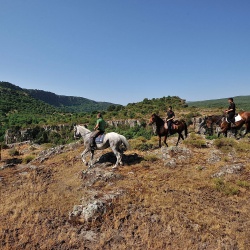

VIVA - New Active Tourism Itineraries in Villanova
Main sections of the site and Thematic sites
Main navigation

The Rock of the Doria family
The rock with its castle and the churches of the Doria family. A breathtaking view over Villanova.
Technical info
Type
A pathway of panoramic and historical interest.
Degree of difficulty
Low difficulty route on easy terrain.
Time required
½ day.
Practicability
Bicycle and walking route.
Departure
Info point in town, Via S. Antonio.
Description
In the vicinity of the info point, in piazza Sant’Antonio (Sant’Antonio Square) there is the Church of Sant’Antonio Abate, also known as Sant’Antonio de Su Fogu, whose construction, according to Romanesque conventions characterised by a one-aisled hall, in view of a lack of documented evidence, and on the basis of formal analysis, can be dated back to the thirteenth century.
Walking down Via S. Antonio, towards the centre of the village, you get to Via Doria, and to the Centre for Documentation on Traditional Breadmaking dedicated to the ancient art of hand-made and hand-decorated bread. The museum, opened in 2011, is set out in the space of a late nineteenth-century house on two floors equipped with an ancient oven built inside a wide fireplace. Following on the same street, it is possible to see the characteristic Parish Church of Santo Stefano with two-aisles and two oriented apses, dating back to two distinct construction phases. The construction of the original structure in the late romanesque style dates back to 1272, according to sources, when the bishop of Bosa allowed some Benedictine monks from San Fruttuoso di Capodimonte to build a church dedicated to Santo Stefano (St Stephen).
At the end of the street after having turned left into Vicolo I Doria and then right into Via Fontana you get to Via del Castello with access to the area where there are the remains of the now destroyed castle built by 1272 by the Genovese Doria family, whose coat of arms can be seen embedded in the walls of the buildings in the village. The castle was dismantled in 1436 on the orders of the King of Aragon after a memorable siege sustained for 3 years by Nicolò Doria against the joint forces of Sassari, Bosa and Alghero.
Coming back along Via del Castello, taking the first street on the right, and then turning right into Via Orti, you get to the Strada Panoramica Subramonte (scenic route) which enables, with an easy path around the hill, the enjoyment of a breathtaking view over the Villanova territory and the Temo lake. Just before arriving in town, for those sporty types passionate about climbing, by following a path it is possible to reach both the cliffs and the Via Ferrata della Regina (The Iron Road of the Queen), a partially equipped path which goes upwards and covers a large part of the ledges which characterise the northern slope of the rocky Su Monte. The ledges are often wide and woody, therefore the path has different degrees of difficulty, where some passages on rock alternate with simple paths. The complete return journey has a length of approximately 600 metres and the parts equipped with rope have an overall progression of approximately 300 metres.





